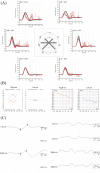Vestibular syncope: clinical characteristics and mechanism
- PMID: 36056529
- PMCID: PMC9539380
- DOI: 10.1002/acn3.51661
Vestibular syncope: clinical characteristics and mechanism
Abstract
Background and objectives: Vestibular syncope is a condition in which vertigo-induced hemodynamic changes cause syncope. This study investigated the clinical and laboratory findings of vestibular syncope and tried to refine our knowledge of the mechanism underlying this newly recognized entity.
Methods: This study retrospectively analyzed 53 patients (33 women, median age = 63 years [interquartile range = 54-71 years]) with vestibular syncope from January 2017 to December 2021. To explain the mechanism of vestibular syncope, we incorporated a velocity-storage model into the dual reflex pathways comprising the vestibulo-sympathetic reflex and baroreflex and predicted the cardiovascular responses.
Results: Twenty (37.7%) patients had multiple episodes of vestibular syncope, and seven (13.2%) had potentially life-threatening injuries. Meniere's disease (20.8%) and benign paroxysmal positional vertigo (9.4%) were the most common underlying vestibular disorders. Abnormal vestibular function tests included impaired cervical vestibular-evoked myogenic potentials (57.5%) and positive head impulse tests (31.0%). Orthostatic hypotension was found in 19.5% of patients. Dyslipidemia (30.2%) and hypertension (28.3%) were common medical comorbidities. The dual reflex pathways incorporating the function of the velocity-storage circuit in the brainstem and cerebellum suggest that vestibular syncope is a neurally mediated reflex syncope associated with a sudden hemodynamic change during vertigo. This change can be arterial hypertension triggered by a false downward inertial cue, as suggested previously, or hypotension driven by a false upward inertial cue.
Conclusions: Vestibular syncope is associated with various vestibular disorders and requires careful evaluation and intervention to prevent recurrent falls and significant injuries.
© 2022 The Authors. Annals of Clinical and Translational Neurology published by Wiley Periodicals LLC on behalf of American Neurological Association.
Conflict of interest statement
Dr. J. Y. Choi serves as an associate editor of
Figures



References
-
- Bogle JM, Benarroch E, Sandroni P. Vestibular‐autonomic interactions: beyond orthostatic dizziness. Curr Opin Neurol. 2022;35(1):126‐134. - PubMed
-
- Pyykkö I, Manchaiah V, Zou J, Levo H, Kentala E. Vestibular syncope: a disorder associated with drop attack in Ménière's disease. Auris Nasus Larynx. 2018;45(2):234‐241. - PubMed
-
- Pyykkö I, Manchaiah V, Zou J, Levo H, Kentala E. Do patients with Meniere's disease have attacks of syncope? J Neurol. 2017;264(1):48‐54. - PubMed
-
- Kwon E, Lee JY, Kim H‐J, Choi J‐Y, Kim J‐S. Can dyssynergia of Vestibulosympathetic and baroreflexes cause vestibular syncope? The hypothesis based on the velocity‐storage function. Cerebellum. 2022;21(2):244‐252. - PubMed
Publication types
MeSH terms
LinkOut - more resources
Full Text Sources
Medical

